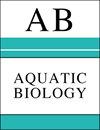Influence of salinity on growth and cell volume in three strains of Prorocentrum cordatum (Dinophyceae)
IF 0.8
4区 生物学
Q3 MARINE & FRESHWATER BIOLOGY
引用次数: 3
Abstract
The aim of this work was to test whether salinity is the driving factor for size and physiological differences in the dinoflagellate Prorocentrum cordatum. Three strains, isolated from 3 sites with different salinities (the central Baltic Sea, Sweden, salinity 8; Chesapeake Bay, Maryland, USA, salinity 16; and the Gulf of Trieste, northern Adriatic Sea, Italy, salinity 32), were included in this study. Following their molecular and morphological characterisation, specific growth rates and dimensions were examined for each strain cultivated at all 3 salinities (i.e. 8, 16 and 32). The Adriatic strain always showed the largest cells and the Baltic strain the smallest. Adriatic and American strains showed lower specific growth rates at salinity 8 and highest at salinity 16. The Baltic strain growth rates were similar at all salinities. As salinity 16 proved to be optimal for the strains, additional parameters were further compared at this salinity: cell volume, particulate organic carbon, particulate nitrogen, delayed fluorescence and in vivo chl a fluorescence. The Adriatic strain had the highest particulate organic carbon, particulate nitrogen, and delayed and in vivo fluorescence. Conversely, the Baltic strain had the lowest values. Although the strains had different specific growth rates with respect to salinity, this was not the main driving factor for the different sizes and photosynthetic activity among the strains. Thus, although there was low genetic variability among strains from the 3 geographical areas, intraspecific variability was suggested.盐度对三株龙骨原心菌生长和细胞体积的影响
这项工作的目的是测试盐度是否是驱动因素的大小和生理差异的鞭毛藻原心心形。3株分离自3个不同盐度地点(波罗的海中部,瑞典,盐度8;切萨皮克湾,马里兰州,美国,盐度16;以及意大利亚得里亚海北部的的里雅斯特湾(盐度32),都被纳入了这项研究。根据分子和形态特征,研究了在所有3种盐度(即8、16和32)下培养的每个菌株的特定生长速率和尺寸。亚得里亚海菌株的细胞数最大,波罗的海菌株的细胞数最小。亚得里亚海和美洲菌株在盐度8时比生长速率较低,在盐度16时比生长速率最高。波罗的海菌株的增长率在所有盐度下都是相似的。由于盐度16被证明是菌株的最佳盐度,我们进一步比较了该盐度下的其他参数:细胞体积、颗粒有机碳、颗粒氮、延迟荧光和体内chl a荧光。亚得里亚海菌株具有最高的颗粒有机碳、颗粒氮、延迟荧光和体内荧光。相反,波罗的海菌株的值最低。虽然菌株的特定生长速率随盐度不同而不同,但这并不是菌株大小和光合活性不同的主要驱动因素。因此,尽管3个地理区域的菌株之间存在较低的遗传变异性,但存在种内变异性。
本文章由计算机程序翻译,如有差异,请以英文原文为准。
求助全文
约1分钟内获得全文
求助全文
来源期刊

Aquatic Biology
生物-海洋与淡水生物学
CiteScore
2.70
自引率
0.00%
发文量
7
审稿时长
3 months
期刊介绍:
AB publishes rigorously refereed and carefully selected Feature Articles, Research Articles, Reviews and Notes, as well as Comments/Reply Comments (for details see MEPS 228:1), Theme Sections, Opinion Pieces (previously called ''As I See It'') (for details consult the Guidelines for Authors) concerned with the biology, physiology, biochemistry and genetics (including the ’omics‘) of all aquatic organisms under laboratory and field conditions, and at all levels of organisation and investigation. Areas covered include:
-Biological aspects of biota: Evolution and speciation; life histories; biodiversity, biogeography and phylogeography; population genetics; biological connectedness between marine and freshwater biota; paleobiology of aquatic environments; invasive species.
-Biochemical and physiological aspects of aquatic life; synthesis and conversion of organic matter (mechanisms of auto- and heterotrophy, digestion, respiration, nutrition); thermo-, ion, osmo- and volume-regulation; stress and stress resistance; metabolism and energy budgets; non-genetic and genetic adaptation.
-Species interactions: Environment–organism and organism–organism interrelationships; predation: defenses (physical and chemical); symbioses.
-Molecular biology of aquatic life.
-Behavior: Orientation in space and time; migrations; feeding and reproductive behavior; agonistic behavior.
-Toxicology and water-quality effects on organisms; anthropogenic impacts on aquatic biota (e.g. pollution, fisheries); stream regulation and restoration.
-Theoretical biology: mathematical modelling of biological processes and species interactions.
-Methodology and equipment employed in aquatic biological research; underwater exploration and experimentation.
-Exploitation of aquatic biota: Fisheries; cultivation of aquatic organisms: use, management, protection and conservation of living aquatic resources.
-Reproduction and development in marine, brackish and freshwater organisms
 求助内容:
求助内容: 应助结果提醒方式:
应助结果提醒方式:


